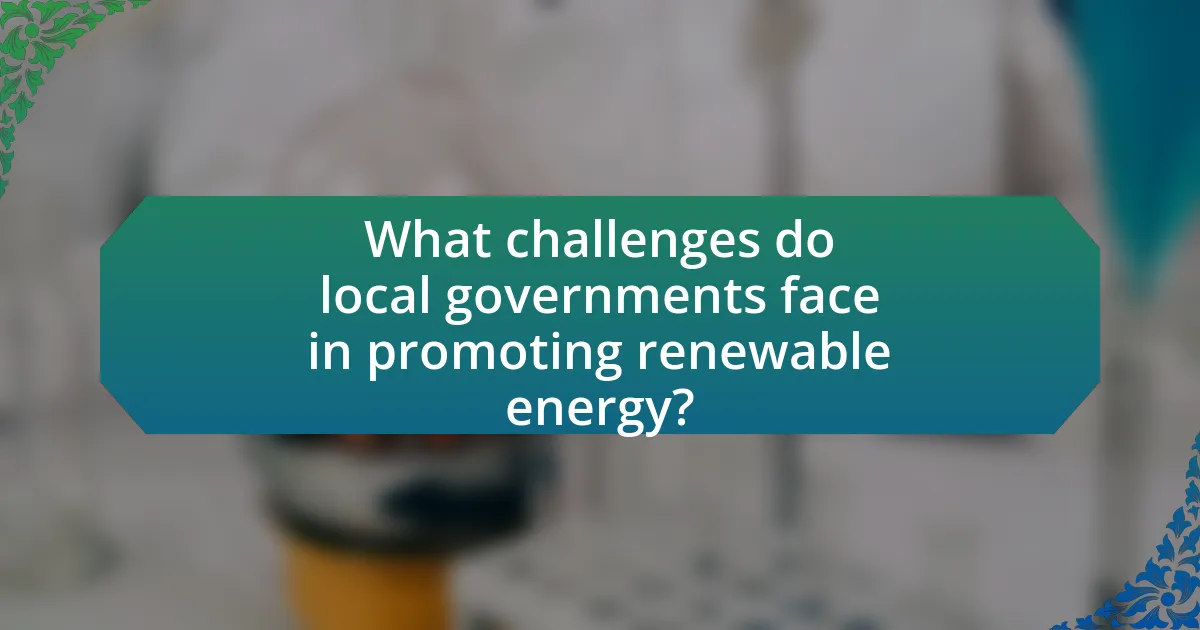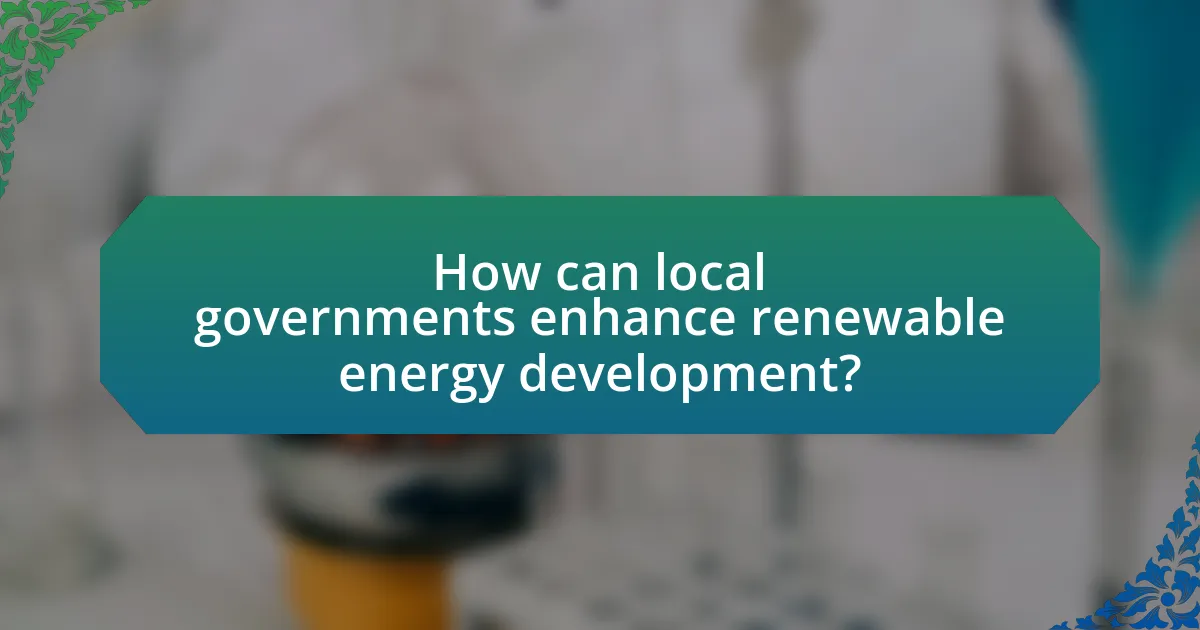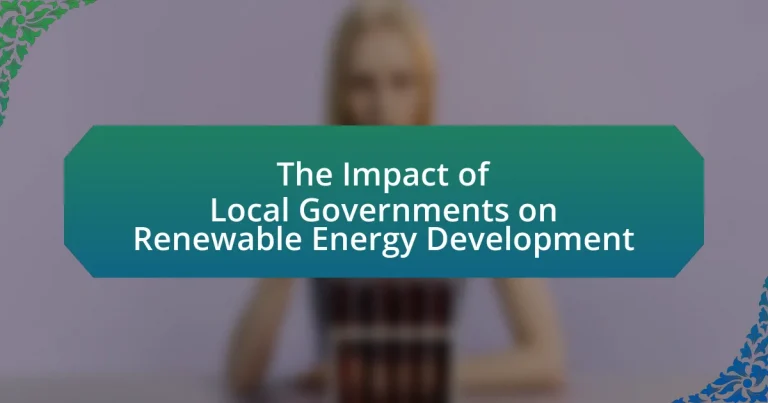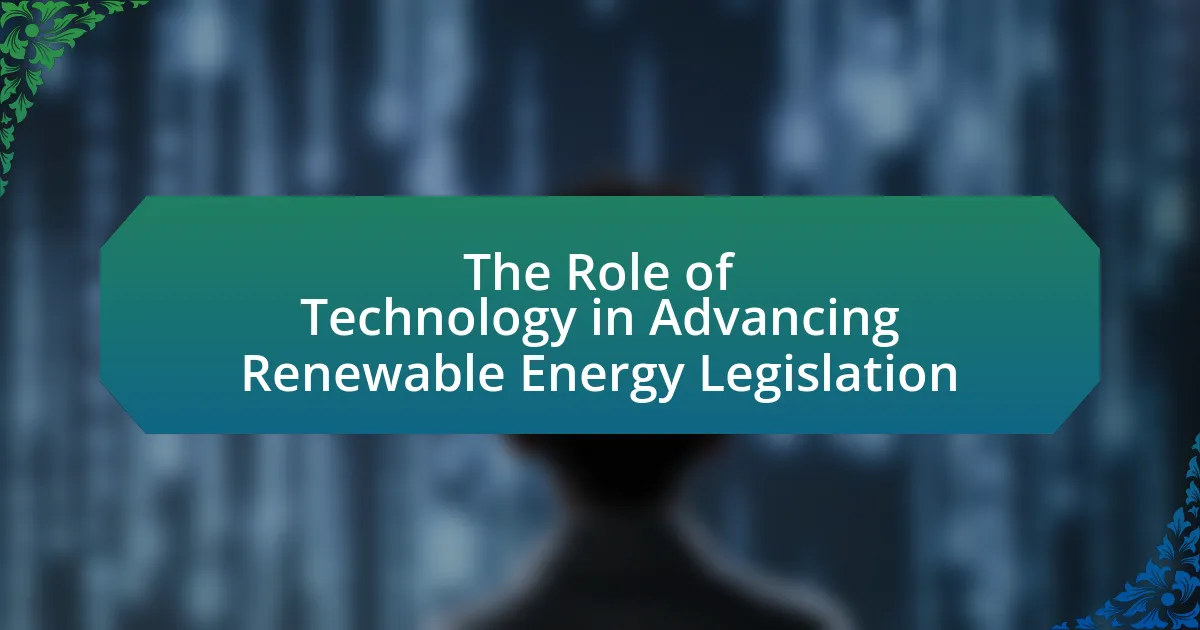Local governments play a pivotal role in the development of renewable energy by implementing policies, regulations, and incentives that facilitate the adoption of clean energy technologies. They influence renewable energy deployment through zoning laws, financial incentives, and community engagement initiatives, which can significantly impact project success and public acceptance. The article explores specific policies local governments adopt, the challenges they face, and the collaborative efforts with stakeholders to enhance renewable energy initiatives. Additionally, it highlights best practices and emerging trends that local governments can leverage to improve renewable energy outcomes and promote sustainable development within their communities.

What is the role of local governments in renewable energy development?
Local governments play a crucial role in renewable energy development by implementing policies, regulations, and incentives that promote the adoption of renewable energy sources. They are responsible for zoning laws that facilitate the installation of renewable energy infrastructure, such as solar panels and wind turbines, and can provide financial incentives, such as tax breaks or grants, to encourage investment in renewable technologies. For example, according to the National Renewable Energy Laboratory, local governments have been instrumental in the deployment of community solar projects, which allow residents to benefit from solar energy without needing to install panels on their properties. Additionally, local governments often engage in public education campaigns to raise awareness about renewable energy benefits, further driving community support and participation in sustainable practices.
How do local governments influence renewable energy policies?
Local governments influence renewable energy policies through regulatory frameworks, financial incentives, and community engagement initiatives. They establish zoning laws that facilitate or hinder the development of renewable energy projects, such as wind farms and solar installations. For instance, local governments can streamline permitting processes, making it easier for developers to launch renewable energy projects, which directly impacts the speed and scale of renewable energy adoption in their jurisdictions. Additionally, they often provide tax incentives or grants to encourage investment in renewable technologies, which can significantly lower the financial barriers for both businesses and residents. According to the National Renewable Energy Laboratory, local policies can account for up to 50% of the variability in renewable energy deployment across different regions, highlighting their critical role in shaping energy landscapes.
What specific policies do local governments implement to promote renewable energy?
Local governments implement specific policies such as renewable energy incentives, zoning regulations, and community solar programs to promote renewable energy. Renewable energy incentives often include tax credits, rebates, and grants that encourage residents and businesses to invest in solar panels, wind turbines, and other renewable technologies. Zoning regulations facilitate the installation of renewable energy systems by streamlining permitting processes and allowing for the development of renewable energy projects in designated areas. Community solar programs enable multiple participants to invest in a shared solar installation, making renewable energy more accessible to those who cannot install systems on their own properties. These policies collectively enhance local renewable energy adoption and contribute to sustainability goals.
How do local governments collaborate with other stakeholders in renewable energy initiatives?
Local governments collaborate with other stakeholders in renewable energy initiatives through partnerships, policy development, and funding mechanisms. These collaborations often involve engaging with private sector companies, non-profit organizations, and community groups to create comprehensive renewable energy plans. For instance, local governments may establish joint ventures with private firms to develop solar or wind projects, leveraging shared resources and expertise. Additionally, they often participate in regional energy planning efforts, aligning their goals with state and federal policies to secure funding and technical assistance. Evidence of this collaboration can be seen in initiatives like the Solar America Cities program, where local governments worked with the U.S. Department of Energy and private stakeholders to promote solar energy adoption, resulting in significant increases in solar installations across participating cities.
Why is local government involvement crucial for renewable energy projects?
Local government involvement is crucial for renewable energy projects because it ensures alignment with community needs and regulatory compliance. Local governments play a key role in zoning, permitting, and providing incentives that facilitate the development of renewable energy infrastructure. For instance, according to the National Renewable Energy Laboratory, local policies can significantly influence the deployment of solar energy systems by streamlining the permitting process and offering tax incentives, which can lead to a 20% increase in installation rates. Additionally, local governments can engage residents in decision-making, fostering public support and addressing concerns, which is essential for the successful implementation of renewable energy initiatives.
What unique advantages do local governments provide in renewable energy development?
Local governments provide unique advantages in renewable energy development through localized knowledge, regulatory flexibility, and community engagement. Their understanding of local resources and needs allows for tailored energy solutions that align with community priorities. For instance, local governments can implement zoning laws that facilitate the installation of renewable energy infrastructure, such as solar panels and wind turbines, which can lead to increased adoption rates. Additionally, they often have the ability to streamline permitting processes, reducing the time and cost associated with project development. According to a report by the National Renewable Energy Laboratory, local policies can significantly influence renewable energy deployment, demonstrating the critical role local governments play in fostering sustainable energy initiatives.
How does local government support impact community acceptance of renewable energy?
Local government support significantly enhances community acceptance of renewable energy projects. When local governments actively endorse renewable energy initiatives through policies, incentives, and public engagement, they foster trust and reduce opposition among community members. For instance, a study by the National Renewable Energy Laboratory found that communities with strong local government backing for renewable energy projects experienced a 30% increase in public support compared to those without such support. This correlation indicates that local government actions, such as facilitating community meetings and providing financial incentives, directly influence public perception and acceptance of renewable energy solutions.

What challenges do local governments face in promoting renewable energy?
Local governments face significant challenges in promoting renewable energy, primarily due to limited financial resources and regulatory constraints. Many local governments operate under tight budgets, which restrict their ability to invest in renewable energy projects or incentivize private sector participation. Additionally, complex regulatory frameworks and permitting processes can hinder the implementation of renewable energy initiatives, as local governments must navigate various state and federal regulations. For instance, a report by the National Renewable Energy Laboratory indicates that local governments often lack the technical expertise required to effectively plan and execute renewable energy projects, further complicating their efforts.
How do funding limitations affect local government renewable energy initiatives?
Funding limitations significantly hinder local government renewable energy initiatives by restricting the financial resources available for project development and implementation. Without adequate funding, local governments struggle to invest in necessary infrastructure, technology, and workforce training essential for renewable energy projects. For instance, a study by the National Renewable Energy Laboratory found that municipalities with limited budgets often delay or scale back renewable energy projects, resulting in missed opportunities for energy savings and emissions reductions. Additionally, funding constraints can lead to reliance on less innovative, lower-impact solutions, ultimately stalling progress toward sustainability goals.
What strategies can local governments use to overcome funding challenges?
Local governments can overcome funding challenges by diversifying revenue sources, implementing public-private partnerships, and pursuing grants and federal funding. Diversifying revenue sources, such as increasing local taxes or fees, allows municipalities to generate additional income. Public-private partnerships enable local governments to collaborate with private entities, sharing costs and resources for renewable energy projects. Additionally, local governments can apply for grants from state and federal programs specifically aimed at supporting renewable energy initiatives, such as the U.S. Department of Energy’s funding opportunities, which have allocated billions for clean energy projects. These strategies collectively enhance financial stability and promote sustainable development in the renewable energy sector.
How do regulatory hurdles impact local renewable energy projects?
Regulatory hurdles significantly impede local renewable energy projects by creating barriers to entry and increasing project costs. These hurdles often include complex permitting processes, stringent zoning laws, and lengthy approval timelines, which can delay project initiation and discourage investment. For instance, a study by the National Renewable Energy Laboratory found that regulatory delays can extend project timelines by an average of 6 to 12 months, leading to increased financing costs and potential loss of investor interest. Additionally, local governments may impose specific requirements that limit the types of renewable technologies that can be deployed, further constraining project viability.
What role does public engagement play in local government renewable energy efforts?
Public engagement is crucial in local government renewable energy efforts as it fosters community support, enhances transparency, and encourages collaborative decision-making. Engaged citizens are more likely to advocate for and participate in renewable energy initiatives, leading to increased project acceptance and success. For instance, a study by the National Renewable Energy Laboratory found that community involvement in planning processes significantly improves project outcomes and public perception. This active participation not only helps identify local needs and preferences but also builds trust between local governments and residents, ultimately driving the adoption of sustainable energy solutions.
How can local governments effectively communicate renewable energy benefits to the public?
Local governments can effectively communicate renewable energy benefits to the public by utilizing clear messaging, engaging community outreach programs, and leveraging social media platforms. Clear messaging involves simplifying complex concepts related to renewable energy, such as cost savings and environmental impacts, to ensure understanding among diverse audiences. Community outreach programs, such as workshops and informational sessions, allow local governments to interact directly with residents, fostering trust and encouraging dialogue. Additionally, social media platforms can be used to disseminate information quickly and widely, reaching a larger audience and facilitating real-time engagement. Research indicates that communities with active local government communication strategies see higher public support for renewable energy initiatives, as evidenced by a study from the National Renewable Energy Laboratory, which found that informed communities are more likely to adopt renewable technologies.
What methods can local governments use to involve citizens in renewable energy planning?
Local governments can involve citizens in renewable energy planning through public consultations, participatory budgeting, and community workshops. Public consultations allow citizens to voice their opinions and provide feedback on proposed renewable energy projects, ensuring that community needs are addressed. Participatory budgeting enables residents to have a direct say in how funds are allocated for renewable energy initiatives, fostering a sense of ownership and responsibility. Community workshops facilitate education and discussion about renewable energy options, helping citizens understand the benefits and challenges associated with these projects. These methods have been shown to enhance community engagement and support for renewable energy initiatives, as evidenced by case studies in cities like San Diego and Portland, where citizen involvement has led to more successful and accepted renewable energy policies.

How can local governments enhance renewable energy development?
Local governments can enhance renewable energy development by implementing supportive policies and providing financial incentives. For instance, local governments can establish zoning regulations that favor renewable energy installations, such as solar panels and wind turbines, thereby facilitating their deployment. Additionally, offering tax credits or grants for renewable energy projects can significantly lower the financial barriers for both businesses and residents. According to a report by the National Renewable Energy Laboratory, local policies that streamline permitting processes can reduce installation costs by up to 30%, demonstrating the effectiveness of local government actions in promoting renewable energy initiatives.
What best practices can local governments adopt for successful renewable energy projects?
Local governments can adopt several best practices for successful renewable energy projects, including stakeholder engagement, policy support, and financial incentives. Engaging stakeholders, such as community members and local businesses, fosters collaboration and addresses concerns, which can lead to greater project acceptance and success. Policy support, including streamlined permitting processes and clear regulations, facilitates project development and reduces delays. Financial incentives, such as grants or tax credits, can attract investment and lower the cost of renewable energy projects. Evidence from the National Renewable Energy Laboratory indicates that communities with strong stakeholder engagement and supportive policies see higher rates of renewable energy adoption, demonstrating the effectiveness of these practices.
How can local governments leverage partnerships to boost renewable energy initiatives?
Local governments can leverage partnerships with private sector companies, non-profits, and community organizations to boost renewable energy initiatives effectively. By collaborating with these entities, local governments can access additional funding, technical expertise, and innovative technologies that enhance project feasibility and implementation. For instance, partnerships with utility companies can facilitate the integration of renewable energy sources into existing grids, while collaborations with non-profits can help in community outreach and education, increasing public support for renewable projects. Evidence of successful partnerships can be seen in cities like San Diego, which partnered with local businesses to develop solar energy programs, resulting in a significant increase in solar installations and a reduction in greenhouse gas emissions.
What innovative approaches can local governments take to promote renewable energy adoption?
Local governments can promote renewable energy adoption through innovative approaches such as implementing community solar programs, offering financial incentives, and establishing renewable energy cooperatives. Community solar programs allow residents to invest in shared solar installations, making renewable energy accessible to those who cannot install solar panels on their properties. Financial incentives, such as tax credits or rebates for solar installations, encourage homeowners and businesses to transition to renewable energy sources. Additionally, renewable energy cooperatives enable residents to collectively invest in and benefit from renewable energy projects, fostering community engagement and reducing costs. These strategies have been shown to increase renewable energy adoption rates, as evidenced by successful implementations in cities like San Diego and Burlington, which have significantly increased their renewable energy capacity through such initiatives.
What are the future trends for local governments in renewable energy development?
Local governments are increasingly focusing on decentralized renewable energy systems, which allow for localized energy production and consumption. This trend is driven by the need for energy resilience, cost savings, and community engagement. For instance, cities like San Diego and Burlington have implemented community solar programs, enabling residents to invest in and benefit from renewable energy projects. Additionally, local governments are adopting policies that promote energy efficiency and sustainability, such as building codes that require renewable energy installations in new developments. According to the National League of Cities, over 70% of local governments are prioritizing renewable energy initiatives, reflecting a significant shift towards sustainable energy practices at the municipal level.
How might technological advancements influence local government strategies in renewable energy?
Technological advancements significantly influence local government strategies in renewable energy by enabling more efficient energy production, distribution, and consumption. For instance, the integration of smart grid technology allows local governments to optimize energy management, reducing waste and enhancing reliability. Additionally, advancements in solar panel efficiency and energy storage solutions, such as lithium-ion batteries, empower local governments to implement more effective solar energy programs, leading to increased adoption rates among residents. According to the U.S. Department of Energy, the cost of solar energy has decreased by over 80% since 2010, prompting local governments to invest in solar infrastructure and incentives. These advancements not only facilitate the transition to renewable energy but also align with local sustainability goals, ultimately shaping comprehensive energy policies that promote environmental stewardship and economic growth.
What emerging policies should local governments consider for sustainable energy growth?
Local governments should consider implementing policies that promote renewable energy incentives, such as tax credits and grants for solar and wind energy installations. These incentives can significantly increase the adoption of sustainable energy technologies, as evidenced by a report from the National Renewable Energy Laboratory, which found that financial incentives can boost solar adoption by up to 50%. Additionally, local governments should establish renewable energy standards that require a certain percentage of energy to come from renewable sources, which has been shown to drive investment in clean energy infrastructure. Furthermore, policies that facilitate community solar projects can enhance access to renewable energy for residents who cannot install solar panels on their properties, thereby expanding participation in sustainable energy growth.
What practical steps can local governments take to improve renewable energy outcomes?
Local governments can improve renewable energy outcomes by implementing policies that promote the adoption of clean energy technologies. These policies include providing financial incentives such as tax credits and grants for renewable energy projects, which can significantly lower the initial investment costs for businesses and homeowners. For instance, a study by the National Renewable Energy Laboratory found that local incentives can increase solar adoption rates by up to 50%.
Additionally, local governments can streamline permitting processes to reduce bureaucratic delays, making it easier for renewable energy projects to get started. Research from the Solar Foundation indicates that simplifying these processes can cut project timelines by 30%.
Furthermore, local governments can invest in public education campaigns to raise awareness about the benefits of renewable energy, which can lead to increased community support and participation. According to a report by the American Council on Renewable Energy, communities with strong educational outreach see a 40% higher engagement in renewable energy initiatives.
By taking these practical steps, local governments can effectively enhance renewable energy outcomes in their regions.




